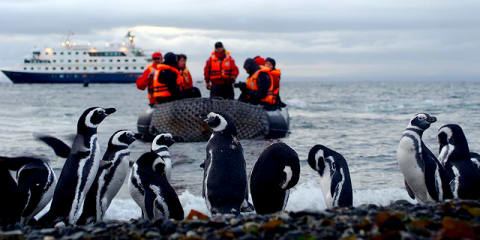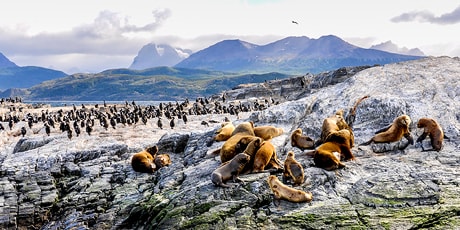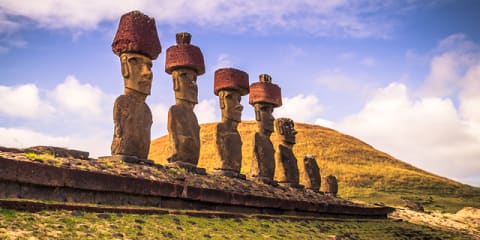Patagonia
Located at the southernmost tip of South America and spanning across portions of Chile and Argentina lies Patagonia, a land full of sprawling snow-capped mountains, lush flora and fauna, icy lakes and glaciers, and countless penguins and other wildlife. Sail around the pristine inlets and waterways in Tierra del Fuego and through the Strait of Magellan. Look in awe across the rough waters of the Drake Passage. Hear the low groaning and creaking of towering glaciers and maybe witness large chunks of ice detaching and falling to the waters below. Patagonia is full of natural treasures, fascinating beauty, and exciting adventures that entice travelers alike.
Highlights
- Glaciers
There are a handful of impressive glaciers that are must-sees in Patagonia. The Pia Glacier settles in Tierra del Fuego along the Chilean Patagonia coast embedded within the Darwin Mountain Range. Listen closely, and you may hear the creaking of ice move – or even witness one of the large ice chunks fall into the water below! Regarded as one of Chile's most beautiful glaciers, the Garibaldi Glacier is only one of three glaciers in Patagonia that is continuously growing. The Perito Moreno Glacier, located in the Los Glaciares National Park in southwest Santa Cruz Province, Argentina, spans over 120 square miles and is still growing! This glacier is another in Patagonia that is continuously growing, over 6 feet per day. While not one of the most famous Patagonian Glaciers, the Águila Glacier is still a beautiful sight! This massive piece of ice is situated at the end of a calm lagoon and surrounded by towering mountains.
- Cape Horn
Discovered in 1616 by a Dutch maritime expedition, Cape Horn is a 1,394-foot high rocky headland overlooking the Drake Passage, marking where the Atlantic and Pacific oceans meet. This lookout point was named after the Netherlands' West Friesland town of Hoorn. Cape Horn was often referred to as the "End of the Earth" since it stands as the southernmost headland of the Tierra del Fuego in southern Chile and was declared a World Biosphere Reserve by UNESCO in 2005. Cape Horn used to be a significant trading route where ships would travel from around the world carrying their traded goods. The waters surrounding Cape Horn, Drake Passage, are especially rough due to strong winds and currents, bulky icebergs, and massive waves.
- Ushuaia
Often referred to as the world's southernmost city, Ushuaia is the most important city on the island of Tierra del Fuego. Situated on a steep hill, Ushuaia overlooks the Beagle Channel and is surrounded by the snow-capped Martial Mountains. Since this city is located at the southernmost tip of Argentina, it serves as the ultimate gateway to Antarctica cruises and tours to "Penguin Island," Isla Yécapasela. In the early twentieth century, the Argentinians started to recognize Ushuaia as a city when it was decided to build a prison on its grounds. Ushuaia's "first settlers" were the prisoners themselves! Today, the prison stands as a museum, and Ushuaia is regarded as a tourist city with an international airport included and the closest deep-water port to the Antarctic.
- Magellanic penguins
Named after the explorer Ferdinand Magellan, whose crew first discovered these tiny birds in 1520, the Magellanic penguins are a South American breed located in coastal Argentina and Chile, with some migrating north to Brazil. The Magellanic penguins are the most prominent example of the Spheniscus (the genus that also includes Galapagos, Humboldt, and African penguins). It is common to find many penguin colonies on Tuckers Islets. With over 3,600,000 Magellanic penguins worldwide, an estimated 1.7 million pairs of them make Patagonia their home for at least part of the year. These penguins flock together when they hunt for food and can live an average of up to 25 years in the wild.
- Walichu Caves
Step back in time and explore the Walichu Caves archaeological site, nestled on Lake Nahuel Huapi's shores in Argentina. Commonly known as Cuevas Galicho, these ancient caves are covered in paintings created by indigenous Tehuelche people dating back 4,000 years ago and offer a glimpse into the lives and rituals of the primitive communities that inhabited the area. The paintings, created by natural pigments made from rocks, minerals, and animal fat, depict various animals and human figures representing the Tehuelche legacy for future generations. In addition to the remarkable paintings, the surrounding area offers stunning views of Lake Argentino, the Andes Mountains, and the Patagonian Steppe.
Fast Facts
Already booked on one of our packages to Patagonia? See everything you need to know before you go.
| Entry requirements | Please see our Entry Requirements page. |
| Weather | The best time to visit Patagonia is from October to March, which is the southern hemisphere spring and summer. Even in these months the weather can be unpredictable and you may experience the legendary Patagonian winds. In April, though the temperatures drop, you will be able to admire the intense colors of the foliage. Average temperatures in the summer range from lows in the 30s to highs in the 60s. The best strategy is to wear layers that you can take on and off as the changing weather may warrant. |
| Dining | The Patagonian steppes are known for beef and lamb, which are staples of Patagonian cuisine. While near the coast, don't miss an opportunity to savor the King Crab, a true Patagonian delicacy. |
| Money & Credit Cards | Always notify your bank prior to departure to avoid any problems using your credit or debit card while traveling. |
| Cell Phones & Internet | Want to take your cell phone, tablet or laptop, but not sure how to get cell service or wifi? Read up on using your cell phone abroad and the top 5 ways to get Internet abroad. |
| Did you know? |
|
Tours & Packages
- Destinations: Patagonia
- including closed packages


Trip Reviews & Photos
We love hearing your stories and seeing your photos! Check out our entire fan photo gallery and upload your photos.

 There are a handful of impressive glaciers that are must-sees in Patagonia. The Pia Glacier settles in Tierra del Fuego along the Chilean Patagonia coast embedded within the Darwin Mountain Range. Listen closely, and you may hear the creaking of ice move – or even witness one of the large ice chunks fall into the water below! Regarded as one of Chile's most beautiful glaciers, the Garibaldi Glacier is only one of three glaciers in Patagonia that is continuously growing. The Perito Moreno Glacier, located in the Los Glaciares National Park in southwest Santa Cruz Province, Argentina, spans over 120 square miles and is still growing! This glacier is another in Patagonia that is continuously growing, over 6 feet per day. While not one of the most famous Patagonian Glaciers, the Águila Glacier is still a beautiful sight! This massive piece of ice is situated at the end of a calm lagoon and surrounded by towering mountains.
There are a handful of impressive glaciers that are must-sees in Patagonia. The Pia Glacier settles in Tierra del Fuego along the Chilean Patagonia coast embedded within the Darwin Mountain Range. Listen closely, and you may hear the creaking of ice move – or even witness one of the large ice chunks fall into the water below! Regarded as one of Chile's most beautiful glaciers, the Garibaldi Glacier is only one of three glaciers in Patagonia that is continuously growing. The Perito Moreno Glacier, located in the Los Glaciares National Park in southwest Santa Cruz Province, Argentina, spans over 120 square miles and is still growing! This glacier is another in Patagonia that is continuously growing, over 6 feet per day. While not one of the most famous Patagonian Glaciers, the Águila Glacier is still a beautiful sight! This massive piece of ice is situated at the end of a calm lagoon and surrounded by towering mountains.  Discovered in 1616 by a Dutch maritime expedition, Cape Horn is a 1,394-foot high rocky headland overlooking the Drake Passage, marking where the Atlantic and Pacific oceans meet. This lookout point was named after the Netherlands' West Friesland town of Hoorn. Cape Horn was often referred to as the "End of the Earth" since it stands as the southernmost headland of the Tierra del Fuego in southern Chile and was declared a World Biosphere Reserve by UNESCO in 2005. Cape Horn used to be a significant trading route where ships would travel from around the world carrying their traded goods. The waters surrounding Cape Horn, Drake Passage, are especially rough due to strong winds and currents, bulky icebergs, and massive waves.
Discovered in 1616 by a Dutch maritime expedition, Cape Horn is a 1,394-foot high rocky headland overlooking the Drake Passage, marking where the Atlantic and Pacific oceans meet. This lookout point was named after the Netherlands' West Friesland town of Hoorn. Cape Horn was often referred to as the "End of the Earth" since it stands as the southernmost headland of the Tierra del Fuego in southern Chile and was declared a World Biosphere Reserve by UNESCO in 2005. Cape Horn used to be a significant trading route where ships would travel from around the world carrying their traded goods. The waters surrounding Cape Horn, Drake Passage, are especially rough due to strong winds and currents, bulky icebergs, and massive waves. Often referred to as the world's southernmost city, Ushuaia is the most important city on the island of Tierra del Fuego. Situated on a steep hill, Ushuaia overlooks the Beagle Channel and is surrounded by the snow-capped Martial Mountains. Since this city is located at the southernmost tip of Argentina, it serves as the ultimate gateway to Antarctica cruises and tours to "Penguin Island," Isla Yécapasela. In the early twentieth century, the Argentinians started to recognize Ushuaia as a city when it was decided to build a prison on its grounds. Ushuaia's "first settlers" were the prisoners themselves! Today, the prison stands as a museum, and Ushuaia is regarded as a tourist city with an international airport included and the closest deep-water port to the Antarctic.
Often referred to as the world's southernmost city, Ushuaia is the most important city on the island of Tierra del Fuego. Situated on a steep hill, Ushuaia overlooks the Beagle Channel and is surrounded by the snow-capped Martial Mountains. Since this city is located at the southernmost tip of Argentina, it serves as the ultimate gateway to Antarctica cruises and tours to "Penguin Island," Isla Yécapasela. In the early twentieth century, the Argentinians started to recognize Ushuaia as a city when it was decided to build a prison on its grounds. Ushuaia's "first settlers" were the prisoners themselves! Today, the prison stands as a museum, and Ushuaia is regarded as a tourist city with an international airport included and the closest deep-water port to the Antarctic.  Named after the explorer Ferdinand Magellan, whose crew first discovered these tiny birds in 1520, the Magellanic penguins are a South American breed located in coastal Argentina and Chile, with some migrating north to Brazil. The Magellanic penguins are the most prominent example of the Spheniscus (the genus that also includes Galapagos, Humboldt, and African penguins). It is common to find many penguin colonies on Tuckers Islets. With over 3,600,000 Magellanic penguins worldwide, an estimated 1.7 million pairs of them make Patagonia their home for at least part of the year. These penguins flock together when they hunt for food and can live an average of up to 25 years in the wild.
Named after the explorer Ferdinand Magellan, whose crew first discovered these tiny birds in 1520, the Magellanic penguins are a South American breed located in coastal Argentina and Chile, with some migrating north to Brazil. The Magellanic penguins are the most prominent example of the Spheniscus (the genus that also includes Galapagos, Humboldt, and African penguins). It is common to find many penguin colonies on Tuckers Islets. With over 3,600,000 Magellanic penguins worldwide, an estimated 1.7 million pairs of them make Patagonia their home for at least part of the year. These penguins flock together when they hunt for food and can live an average of up to 25 years in the wild. Step back in time and explore the Walichu Caves archaeological site, nestled on Lake Nahuel Huapi's shores in Argentina. Commonly known as Cuevas Galicho, these ancient caves are covered in paintings created by indigenous Tehuelche people dating back 4,000 years ago and offer a glimpse into the lives and rituals of the primitive communities that inhabited the area. The paintings, created by natural pigments made from rocks, minerals, and animal fat, depict various animals and human figures representing the Tehuelche legacy for future generations. In addition to the remarkable paintings, the surrounding area offers stunning views of Lake Argentino, the Andes Mountains, and the Patagonian Steppe.
Step back in time and explore the Walichu Caves archaeological site, nestled on Lake Nahuel Huapi's shores in Argentina. Commonly known as Cuevas Galicho, these ancient caves are covered in paintings created by indigenous Tehuelche people dating back 4,000 years ago and offer a glimpse into the lives and rituals of the primitive communities that inhabited the area. The paintings, created by natural pigments made from rocks, minerals, and animal fat, depict various animals and human figures representing the Tehuelche legacy for future generations. In addition to the remarkable paintings, the surrounding area offers stunning views of Lake Argentino, the Andes Mountains, and the Patagonian Steppe.